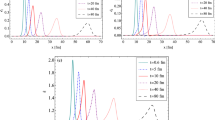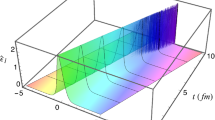Abstract
Surface waves propagating in the semi-bounded collisional hot QCD medium (quark-gluon plasma) are considered. To investigate the effect of collisions as damping and non-ideality factor, the longitudinal and transverse dielectric functions of the quark-gluon plasma are used within the Bhatnagar–Gross–Krook (BGK) approach. The results were obtained both analytically and numerically in the long wavelength limit. First of all, collisions lead to smaller values of surface wave frequency and their stronger damping. Secondly, the results show that non-ideality leads to the appearance of a new branch of surface waves compared to the collisionless case. The relevance of the surface excitations (waves) for the QGP realized in experiments is discussed.


Similar content being viewed by others
REFERENCES
A. Bazavov et al., “Chiral crossover in QCD at zero and non-zero chemical potentials,” Phys. Lett. B 795, 15 (2019).
M. Bonitz, R. Binder, D. Scott, S. Koch, and D. Kremp, “Theory of plasmons in quasi-one-dimensional degenerate plasmas,” Phys. Rev. E 49, 5535 (1994).
D. Scott, R. Binder, M. Bonitz, and S. Koch, “Multiple undamped acoustic plasmons in three-dimensional two-component nonequilibrium plasmas,” Phys. Rev. B 49, 2174 (1994).
P. L. Bhatnagar, E. P. Gross, and M. Krook, “A model for collision processes in gases. I. Small amplitude processes in charged and neutral one-component systems,” Phys. Rev. 94, 511 (1954).
P. Chakraborty, M. Golam Mustafa, R. Ray, and M. H. Thoma, “Wakes in a collisional quark-gluon plasma,” J. Phys. G 34, 2141 (2007).
M. E. Carrington, T. Fugleberg, D. Pickering, and M. H. Thoma, “Dielectric functions and dispersion relations of ultrarelativistic plasmas with collisions,” Can. J. Phys. 82, 671 (2004).
P. Chakraborty, M. G. Mustafa, and M. H. Thoma, “Wakes in the quark-gluon plasma,” Phys. Rev. D 74, 094002 (2006).
M. Carrington, K. Deja, and S. Mrowczynski, “Plasmons in anisotropic quark-gluon plasma,” Phys. Rev. C 90, 034913 (2014).
Bing-feng Jiang and Jia-rong Li, “The dielectric function of the viscous quark-gluon plasma,” Nucl. Phys. A 847, 268 (2010).
Bing-feng Jiang and Jia-Rong Li, “The wake potential in the viscous quark-gluon plasma,” Nucl. Phys. A 856, 121 (2011).
M. Gyulassy and M. Plümer, “Jet quenching in dense matter,” Phys. Lett. B 243, 432 (1990).
A. F. Alexandrov, L. S. Bogdankevich, and A. A. Rukhadze, Principles of Plasma Electrodynamics (Springer, Berlin, Heidelberg, 1984), Vol. 9.
Dong-Soo Shin and Young-Dae Jung, “Pair annihilation effects on dust ion acoustic surface wave in semi-bounded magnetized pair-ion-dust plasmas,” Phys. Lett. A 349, 500 (2006).
In-Seok Chang and Young-Dae Jung, “Quantum effects on propagation of surface Langmuir oscillations in semi-bounded quantum plasmas,” Phys. Lett. A 372, 1498 (2008).
Young-Dae Jung and Woo-Pyo Hong, “Quantum and geometric effects on the symmetric and anti-symmetric modes of the surface plasma wave,” Phys. Lett. A 377, 560 (2013).
F. Becattini, J. Manninen, and M. Gaździcki, “Energy and system size dependence of chemical freeze-out in relativistic nuclear collisions,” Phys. Rev. C 73, 044905 (2006).
J. Peralta-Ramos and E. Calzetta, “Effective dynamics of a nonabelian plasma out of equilibrium,” Phys. Rev. D 86, 125024 (2012).
ACKNOWLEDGMENTS
This work has been supported by the MES RK under Grant no. AP08052503 (2020) and by RFBR under grant no. 18-02-40137.
Author information
Authors and Affiliations
Corresponding author
APPENDIX A
APPENDIX A
Taking into account that \(a \ll 1\), we used the following expansion:
Substituting the expansion (A.1) into Eqs. (5) and (6) we get
and
respectively. Neglecting terms of \(\mathcal{O}({{a}^{3}})\) in Eqs. (A.2) and (A.3), and making use of the expansion \({{\left( {1 - \tfrac{{i\tilde {\nu }}}{{\tilde {k}}}a} \right)}^{{ - 1}}} \approx 1 + \tfrac{{i\tilde {\nu }}}{{\tilde {k}}}a\) in Eq. (A.2), we arrive at
and
Finally, dropping terms of \(\mathcal{O}({{a}^{3}})\) in Eqs. (A.4) and (A.5), we get expressions (7) and (8).
Rights and permissions
About this article
Cite this article
Baiseitov, K., Moldabekov, Z.A., Blaschke, D. et al. Surface Waves in a Collisional Quark-Gluon Plasma. Phys. Part. Nuclei Lett. 17, 803–808 (2020). https://doi.org/10.1134/S1547477120060035
Received:
Revised:
Accepted:
Published:
Issue Date:
DOI: https://doi.org/10.1134/S1547477120060035




